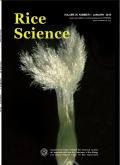Breeding for Heat Tolerant Aromatic Rice Varieties and Identification of Novel QTL Regions Associated with Heat Tolerance During Reproductive Phase by QTL-Seq
IF 5.6
2区 农林科学
Q1 AGRONOMY
引用次数: 0
Abstract
Extremely high temperatures resulting from climate change have become a major challenge for increasing rice production. Therefore, our objective was to develop heat-tolerant aromatic rice varieties using the pedigree method, focusing on selecting for seed-setting ability under extremely high temperatures along with the use of single nucleotide polymorphism/insertion and deletion (SNP/InDel) markers to improve aromatic properties and grain quality. Furthermore, the QTL-seq approach was utilized to identify QTLs for seed-setting rate in an F2 population subjected to heat stress. The candidate QTL regions were then aligned to confirm SNPs/InDels in synonymous F7 candidate heat-tolerant lines. The results revealed that four promising lines, namely 84-7-1-9, 84-7-1-10, 159-3-3-1, and 159-3-3-10, were classified as heat-tolerant with low amylose content. In addition, lines 84-7-1-9 and 84-7-1-10 were identified as aromatic rice encompassing the aroma gene (badh2). Regarding the QTL-seq results, the qSF2.1 region ranged from 311 051 to 3 929 422 bp on chromosome 2, was identified based on the highest contrasting SNP index between the heat-susceptible and tolerant bulks. The candidate genes within this region include two genes related to heat shock proteins, three genes associated with pollen fertility, and four genes involved in heat stress and other abiotic stress responses. These genes are proposed as potential candidates for heat tolerance and could serve as targets in rice breeding programs aimed at enhancing heat tolerance.
求助全文
约1分钟内获得全文
求助全文
来源期刊

Rice Science
Agricultural and Biological Sciences-Agronomy and Crop Science
CiteScore
8.90
自引率
6.20%
发文量
55
审稿时长
40 weeks
期刊介绍:
Rice Science is an international research journal sponsored by China National Rice Research Institute. It publishes original research papers, review articles, as well as short communications on all aspects of rice sciences in English language. Some of the topics that may be included in each issue are: breeding and genetics, biotechnology, germplasm resources, crop management, pest management, physiology, soil and fertilizer management, ecology, cereal chemistry and post-harvest processing.
 求助内容:
求助内容: 应助结果提醒方式:
应助结果提醒方式:


